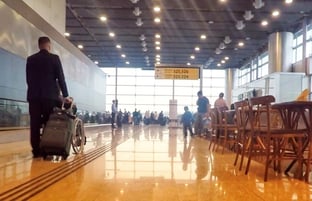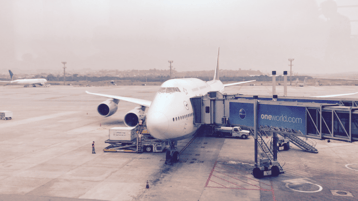10 tips on how to take a long-haul flight with SCI | Guest blogger Rodrigo Souza - Blog - Reeve Foundation
Traveling is my favorite hobby, few things in life give me more pleasure than getting out there with my camera and exploring cities and countries, talking to people you never met before, eat food you've never eaten, starting your day not knowing how it would end and so on.
Traveling is really amazing but since I got injured (June 2014) I kind of lost a little bit of my confidence. Traveling after my injury became a challenging experience, especially when you need to take a long-haul flight, in a wheelchair, solo.
Since I live in Sweden and Mum lives in Brazil (about 12 to 14 hours flying) I had not much choice but to jump on a plane and cross the Atlantic every year, especially for Christmas.
After getting it done a few times and learning by experience, I wrote down a few tips to make your long-haul flight a bit more pleasurable.
Here they are:
1 - Try to book an overnight flight and a direct flight. I know it may cost you some extra bucks but try to avoid layovers, so you will be less tired once you reach your destination.
2 - Try to book a window seat. This way you will avoid being in the way of someone and you can relax and enjoy your time without bothering anyone.
 3 - Wear comfortable clothes. As you will be sitting down in the same position over a long period of time, try to avoid wearing jeans or any other trousers with back pockets in it to make sure you don't get any pressure sores. Get yourself some loose and comfortable joggers and also wear a pair of compression socks, as you will be sitting for a long time and you want to avoid getting swollen feet. It's also a good idea to avoid carbonated drinks and sweeteners as it also could make your feet swell.
3 - Wear comfortable clothes. As you will be sitting down in the same position over a long period of time, try to avoid wearing jeans or any other trousers with back pockets in it to make sure you don't get any pressure sores. Get yourself some loose and comfortable joggers and also wear a pair of compression socks, as you will be sitting for a long time and you want to avoid getting swollen feet. It's also a good idea to avoid carbonated drinks and sweeteners as it also could make your feet swell.
4 - Once at the airport, check in your main luggage at the airline counter and let them know if you need any kind of assistance to get in and out of the plane or with your hand luggage.
5 - Going through the airport security is the same as an able-bodied human, it's actually a bit better as you skip the queues at the security border. Remember to get all your stuff together and keep a doctor's note with your medication in case they ask what it is you are carrying.
6 - You will probably be one of the first to get on the plane, when your time comes, make sure to keep all the loose parts of your wheelchair with you, including side arms and wheelchair cushion. Depending on the size of the plane you can either roll in all the way to your seat and transfer straight way but generally, you will transfer to a small chair before getting in the airplane and they will guide you to your seat.
7 - As you take your wheelchair cushion with you, and place it in the airplane seat. Make sure to perform some pressure release from time to time, you can do that by lifting your legs one at a time and also you can stretch your back by leaning forward. This way you will avoid pressure sores and reduce your muscle spasms during the flight.
8- As a paraplegic (T3 complete), I have neurogenic bladder and bowel. It means that I don't have control over it and I need to schedule the time when I need to visit the bathroom. So one of the main thing is to find out how you are going to manage your bladder and your bowel during the flight. Unfortunately, airlines are not yet well equipped with accessible bathrooms and once you are in the plane you probably will remain in your seat throughout the journey.
9- The best way I found to manage my bladder is to use an indwelling Foley catheter. Attach it to a leg bag and you are good to go. If you want something less invasive you can use a conveen/uri-dome. Make sure to empty your leg bag before boarding the plane and also take an empty water bottle with you in your handbag in case you need it.
I also try to avoid drinking coffee, soft drinks and alcohol 12 hours before my flight as they are diuretics  and make you want to visit the toilet more often. Stick with water folks.
and make you want to visit the toilet more often. Stick with water folks.
To manage my bowels, I always try to have a bowel program on the day of the flight. Also, try to avoid junk and greasy food such as hamburgers, hot dogs, pizza or anything that contains dairy and processed meat at least 2 days prior to the flight. Try to eat plenty of fruits and vegetables, whole greens and I also request a vegetarian meal on the plane. Go easy on yourself and eat healthily.
10 - Lastly, an important tip is how to pack your carry-on bag, the bag that you going to take with you in the plane, the bag that will stay with you all the time.
You need to make sure to pack all the stuff you need such as catheters, toilet paper, washcloths, extra trousers, underwear, socks, diapers, tablets and all your prescribed medicine along with a doctor’s note.
Basically, you have ask yourself - what can possibly go wrong while I am on the plane? You need to be prepared for everything and let me tell you, anything can happen. It happened to me once where I was unprepared and it wasn't beautiful, well let’s not go there.
There are a few limitations and there will be a few things that eventually will not go the way you planned but that is what makes traveling exciting.
Remember to keep positive and have fun. You got this, you can make it work.
Rodrigo Souza is an avid traveler and creater of the blog: - www.goodtimetorollon.com
Join Our Movement
What started as an idea has become a national movement. With your support, we can influence policy and inspire lasting change.
Become an Advocate